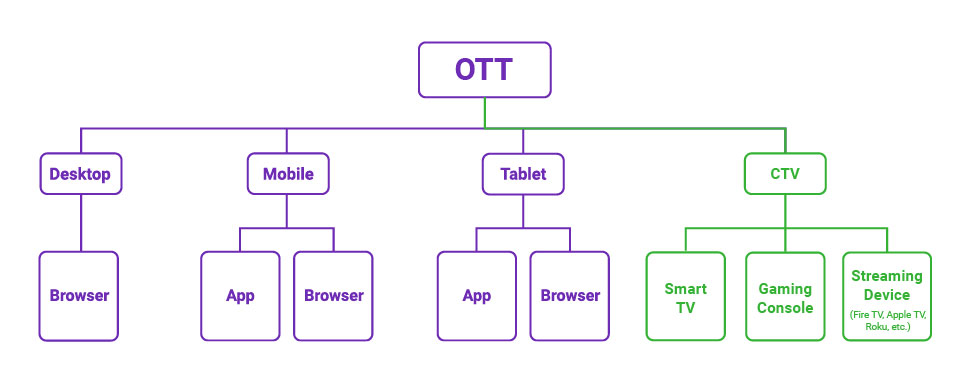Viewership and ad spend are dramatically increasing across CTV and OTT, yet many in the industry are incorrectly using these terms interchangeably to convey a premium TV-like experience on a large format screen. The truth is that these two terms are not interchangeable, and frequently don’t equate to a premium TV-like experience.
OTT (over-the-top) has been used to refer to a variety of content delivery environments, however, the most basic definition refers to video delivered over the internet rather than through a traditional cable TV box. OTT in this definition is essentially a new term for digital video. That can mean TV content delivered to a large-format screen, but it can also mean lower quality video delivered to an old cellphone. This device-agnostic definition is already utilized by eMarketer as well as half of US marketers according to an April 2019 IAB and Advertiser Perceptions poll.
Some in the industry try to utilize a more nuanced definition for OTT to convey a more specific or premium environment. This has made it difficult to have a common understanding of OTT, particularly as the lines between video services and content quality blur. Common variations on the definition of OTT include:
- Only premium film/TV or long form content
- Content served by Virtual MVPDs
- Environments without paywalls
- Video on a CTV device
While OTT media buyers may believe they are getting only large-screen TV inventory, this is typically not the case. By its standard definition, OTT doesn’t associate itself with any one specific device or any specific content. The safest approach in buying OTT media is to assume it is simply digital video.
CTV (Connected TV) is your large TV screen that is connected to the internet, either directly or through a gaming console or streaming device. It is a device, just like a mobile phone, a tablet, or a desktop computer. A media buy of CTV inventory can generally be assumed to be running in a large screen format.
CTV itself isn’t directly related to any specific type of content. A CTV media buy could include premium television content, or it could include user-generated content.

Media buyers seeking inventory from large format TV screens should be looking for CTV specific inventory. Want that inventory to also run alongside premium content? Buying media labeled either OTT or CTV would not guarantee or even indicate that your ad runs against premium content. To guarantee a premium environment, media buyers must confirm what is being purchased directly with publishers and validate with third-party verification partners.
DV’s own offering provides media buyers with the insights they need to understand where their CTV and OTT buys are actually delivering. Devices and apps that a campaign runs in are included in standard reporting. While CTV app reporting has been historically difficult due to a lack of naming standards, DV has normalized app names for over 6,000 apps across all major CTV devices, making it possible to have clarity and confidence in your digital investment.
For more information about DV’s CTV solutions, download our guide.

